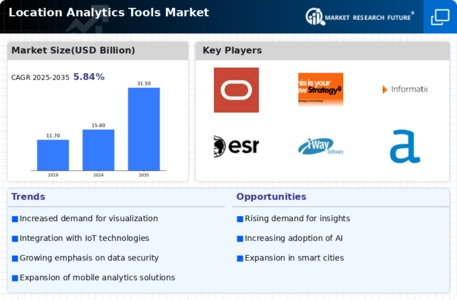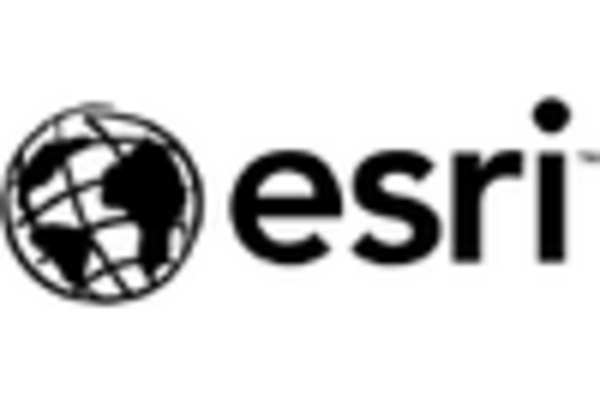Expansion of E-Commerce and Retail Sectors
The Location Analytics Tools Market is significantly influenced by the expansion of e-commerce and retail sectors. As online shopping continues to gain traction, retailers are increasingly utilizing location analytics to enhance customer experiences and optimize supply chain logistics. By analyzing geographic data, businesses can identify trends in consumer behavior, tailor marketing strategies, and improve inventory management. Reports indicate that the e-commerce sector is expected to reach a valuation of over 6 trillion dollars by 2024, which underscores the importance of location analytics in understanding market dynamics. This trend is likely to propel the demand for location analytics tools, as retailers seek to leverage data to gain a competitive edge.
Rising Demand for Data-Driven Decision Making
The Location Analytics Tools Market is experiencing a surge in demand as organizations increasingly recognize the value of data-driven decision making. Companies across various sectors are leveraging location analytics to gain insights into customer behavior, optimize operations, and enhance strategic planning. According to recent estimates, the market for location analytics tools is projected to grow at a compound annual growth rate of approximately 15% over the next five years. This growth is fueled by the need for businesses to make informed decisions based on geographical data, which can lead to improved efficiency and profitability. As organizations strive to remain competitive, the adoption of location analytics tools becomes essential, thereby driving the market forward.
Government Initiatives for Smart Infrastructure
The Location Analytics Tools Market is being propelled by government initiatives aimed at developing smart infrastructure. Many governments are investing in technology to enhance urban planning, transportation systems, and public services. Location analytics plays a crucial role in these initiatives by providing insights that inform policy decisions and resource allocation. For instance, the integration of location data in public transportation planning can lead to more efficient routes and reduced congestion. As governments increasingly prioritize smart city projects, the demand for location analytics tools is expected to rise, creating opportunities for vendors in this space. This trend indicates a growing recognition of the importance of location intelligence in shaping modern urban environments.
Advancements in Geographic Information Systems (GIS)
The Location Analytics Tools Market is benefiting from advancements in Geographic Information Systems (GIS) technology. Innovations in GIS are enabling more sophisticated data analysis and visualization capabilities, which are essential for effective location analytics. As organizations seek to harness the power of spatial data, the integration of advanced GIS tools into location analytics platforms is becoming increasingly common. This evolution is likely to enhance the accuracy and efficiency of location-based insights, thereby driving market growth. Furthermore, the increasing availability of high-resolution satellite imagery and real-time data feeds is expected to further enrich the capabilities of location analytics tools, making them indispensable for businesses across various sectors.
Growing Importance of Customer Experience Management
The Location Analytics Tools Market is increasingly influenced by the growing importance of customer experience management. Businesses are recognizing that understanding customer preferences and behaviors is vital for fostering loyalty and driving sales. Location analytics provides valuable insights into customer journeys, enabling organizations to tailor their offerings and improve service delivery. As companies invest in enhancing customer experiences, the demand for location analytics tools is likely to rise. Research indicates that organizations that prioritize customer experience can achieve revenue growth rates of 4-8% higher than their competitors. This trend underscores the critical role of location analytics in shaping customer-centric strategies, thereby propelling market growth.


















Leave a Comment